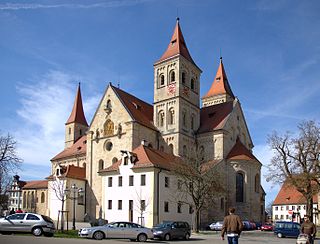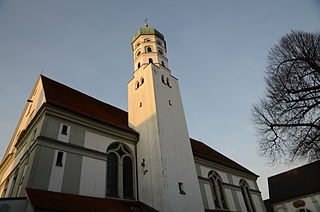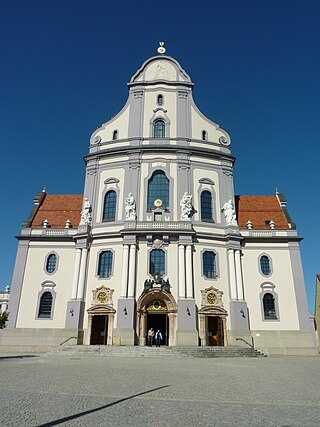
Ulrich of Augsburg, sometimes spelled Uodalric or Odalrici, was Prince-Bishop of Augsburg in the Holy Roman Empire. He was the first saint to be canonized not by a local authority but by the pope.

Cathedrals, collegiate churches, and monastic churches like those of abbeys and priories, often have certain complex structural forms that are found less often in parish churches. They also tend to display a higher level of contemporary architectural style and the work of accomplished craftsmen, and occupy a status both ecclesiastical and social that an ordinary parish church rarely has. Such churches are generally among the finest buildings locally and a source of regional pride. Many are among the world's most renowned works of architecture. These include St Peter's Basilica, Notre-Dame de Paris, Cologne Cathedral, Salisbury Cathedral, Antwerp Cathedral, Prague Cathedral, Lincoln Cathedral, the Basilica of Saint-Denis, Santa Maria Maggiore, the Basilica of San Vitale, St Mark's Basilica, Westminster Abbey, Saint Basil's Cathedral, Antoni Gaudí's incomplete Sagrada Família and the ancient cathedral of Hagia Sophia in Istanbul, now a mosque.

Saint Afra was martyred during the Diocletian persecution. Along with Saint Ulrich & St Simpert, she is a patron saint of Augsburg. Her feast day is August 7. Afra was dedicated to the service of the goddess Venus by her mother, Hilaria. Through his teachings, Bishop Narcissus converted Afra and her family to Christianity. When it was learned that Afra was a Christian, she was brought before Diocletian and ordered to sacrifice to the pagan gods. She refused and was condemned to death by fire.

Angela Merici was an Italian Catholic religious educator who founded the Company of St. Ursula in 1535 in Brescia, in which women dedicated their lives to the service of the church through the education of girls.

The Archdiocese of Munich and Freising is a Latin Church ecclesiastical territory or diocese of the Catholic Church in Bavaria, Germany. It is governed by the Archbishop of Munich and Freising, who administers the see from the co-cathedral in Munich, the Frauenkirche. The other, much older co-cathedral is Freising Cathedral.
Saint Ulrich or Saint Ulric may refer to four saints:

Ottobeuren is a Benedictine abbey, located in Ottobeuren, near Memmingen in the Bavarian Allgäu, Germany.

Tegernsee Abbey is a former Benedictine monastery in the town and district of Tegernsee in Bavaria. Both the abbey and the town that grew up around it are named after the Tegernsee, the lake on the shores of which they are located. The name is from the Old High German tegarin seo, meaning great lake.

Neresheim Abbey or the Abbey of Saints Ulrich and Afra, Neresheim is located above the town of Neresheim in Baden-Württemberg, southern Germany. It is now a Benedictine monastery and is part of the Beuronese Congregation.

Notre-Dame Cathedral is the Catholic cathedral of the Archdiocese of Luxembourg, located in Luxembourg City in southern Luxembourg. It was originally a Jesuit church, and its cornerstone was laid in 1613. It is the only cathedral in Luxembourg.

Ellwangen Abbey was the earliest Benedictine monastery established in the Duchy of Swabia, at the present-day town of Ellwangen an der Jagst, Baden-Württemberg, about 100 km (60 mi) north-east of Stuttgart.

St. Ulrich's and St. Afra's Abbey, Augsburg is a former Benedictine abbey dedicated to Saint Ulrich and Saint Afra in the south of the old city in Augsburg, Bavaria.

Placidus Braun, O.S.B. was a Bavarian Benedictine priest, historian and archivist.

Augsburg-Haunstetten, also known as Haunstetten-Siebenbrunn is one of the seventeen Planungsräume of Augsburg, Bavaria, Germany. It is the largest of the seventeen Planungsräume with an area of 32.59 km² (12.58 mi²). It is one of the most heavily populated subdivisions of Augsburg, with over 25,000 inhabitants. The town of Siebenbrunn was its own entity until 1910 when it was annexed to Augsburg, and Haunstetten was its own city from 1952 until 1972, when Bavaria underwent extensive reform of its political subdivisions and Haunstetten was also annexed to Augsburg. The population stood at 26,291 as of December 31, 2010.

The Prince-Bishopric of Augsburg was one of the prince-bishoprics of the Holy Roman Empire, and belonged to the Swabian Circle. It should not be confused with the larger diocese of Augsburg, over which the prince-bishop exercised only spiritual authority.

St. Lorenz Basilica is a baroque minor Basilica in Kempten, Bavaria, named after the Christian martyr Lawrence of Rome. It is the former abbey church of the Benedictine Kempten Abbey. It is currently used as the parish church of the Roman Catholic parish of St. Lawrence in the Diocese of Augsburg.

The church St. Peter und Alexander is a Catholic church located in Aschaffenburg, Bavaria, Germany. It is the town's oldest church, established in the 10th century, dedicated to Saint Peter and Saint Alexander. The main building was built as a Roman basilica, while other phases were built in the early Gothic style. The current structure is a cruciform basilica, reflecting a variety of styles including a Romanesque nave from the 12th century and a 15th-century tower.

The Basilica of Sts. Peter and Paul also called Dillingen Basilica is a Catholic church located in Dillingen, Germany, which serves as basilica and co-cathedral of the diocese of Augsburg.

The Basilica of St. Ann also called Altötting Basilica It is the main place of Catholic worship of Altötting, Bavaria, in the diocese of Passau. It is the largest church built in Germany in the twentieth century and is located in the Capuchin convent in Bruder-Konrad-Platz.

The Basilica of Our Lady of Nazareth of Exile is a minor basilica of the Catholic Church located in the city of Belém, Pará, Brazil. Its construction started in 1909 at the place where the image of the Virgin of Nazareth was found by Plácido José de Souza in the state of Pará, on the banks of the Murututu Igarapé.





















